Herbaceous and tuberous 2015
 |
Our range of Asiatic species Aconitum is extensive hence there has to be something about them to qualify adding. Aconitum kitadakense BSWJ11173 easily meets that criteria, as was instantly obvious when we first encountered it high in the mountains of Japan in 2005, by its neat and floriferous habit. A small to medium sized species we found growing in a small colony at the edge of a large forested area of Ehime in the cold mountains of Shikoku (island), Japan in the autumn of 2005. Where they formed plants with arching stems to 60cm tall in the lightly shaded conditions, with deeply lobed palmate leaves and sizeable terminal inflorescences of seed capsules the result of the sizeable blue-purple hooded flowers carried July-September.
|
 |
While Anemone rivularis from India BSWJ13944 was already known to us and indeed on our ‘shopping list’, although for a while there we thought we were too late after staggering up to that heady altitude. We need not have been worried of finding this well known species during our high altitude trek on the Singalila Ridge in 2013, where we eventually found a sizeable colony in seed at 3030m. An easily cultivated perennial with stiff upright, branching stems bearing delicate, slightly cup-shaped, white blue-backed flowers May to September, above deeply divided, dark green palmate leaves.
|

|
The opposite was true of Anemone vitifolia WJC13743 etc which again was on the list, but still flowering their not so little heads off. A rare species in gardens, arising from a tufted rootstock from underground shortly creeping stolons. With branched stems to 1.5m tall, but normally only half that in gardens. Bearing 5-9 lobed thick textured leaves silky-woolly beneath and shallowly cupped white flowers to 5cm across held in loose umbels July-September. One of our seed collections made in the eastern Himalayas in 2013.
|
 |
I have previously sung the praises of Clematis flabellata BSWJ8431 being my favourite herbaceous species, although the name has been changed, or is it they cannot make their minds up. All the same its fabulous, distinct on account of the size of flowers. A most unusual non climbing herbaceous perennial species. An undoubted gem of fairly small stature, a woodland species 80-100cm tall. Bearing large roughly heart shaped leaves sometimes 3-lobed fringed with golden brown hairs, but topped with long stalked most unusual flowers. Which are golden-shaggy brown in appearance long lasting and pendant, composed of thick textured pendant sepals, in its largest form in this very hardy variety we collected from Soraksan South Korea in 2001. Followed by large long lasting golden long tailed seed heads.
|
 |
We are always pleased to add another species of Coptis as they are all so useful in their own evergreen way, but some have charming flowers freely born such as Coptis chinensis BSWJ12865 which we obtained in Japan. A clump forming perennial species originating from Chinese forests and shaded valleys. With fern-like evergreen dark green deeply 3-5 lobed serrated foliage, triangular in outline unequally thrice parted to 10cm long and wide. Producing upright central scapes to 25cm tall bearing a 3-8 flowered inflorescences of yellowish green recurving flowers, eventually transforming to a boss of green hooked carpels January to April, depending on weather.
|
 |
Thalictrum integrilobum BSWJ11151 was not only obtained in Japan, but is a rare native. It had long been on my list of must have, as can be seen by the distinct willowy foliage and habit. A very distinct Japanese species from the north of the country, which we have been slowly increasing stocks of for many years, after searching out this rareity for so long. Distinct on account of its unique foliage, which is composed of 3-4 times parted leaves, the single basal leaf sometimes as tall as the flowering stems 20-40cm. While the leaflets are linear-lanceolate 1.5-4cm long by only 3-5mm wide, giving the impression of a weeping plant. The corymbs of white conspicuous stamen are terminal on the upright flowering stem in April to June, while clothes in more foliage.
|
 |
Coming from a completely different background are two wonderful forms of Cardamine coming to us from the late Harry Hay’s garden, namely Cardamine heptaphylla a selected form of this woodland species which arises from swollen scaly rhizomes. Forming slowly spreading colonies in its native mountainous forests of south-western Europe, spreading as far north as Germany. Where the pinnate leaves emerge with clusters of large white flowers April-May, on stems to 20-30cm. Spread 45-60cm. Easily grown in full to part shade, in a drained soil that can retain some moisture during its growing season. Liable to go dormant early if warm and dry
|
 |
Our second species from Harry's garden (Now there was a man who knew his onions) Cardamine pentaphylla. Upright European perennial originating from mountainous forests and shaded slopes of the Pyrenees to southern Germany, Austria and Croatia. Spreading by fleshy, horizontal scaly rhizomes, which produce clusters of large pink flowers in May to June on leafy stems 30-60cm tall.
|
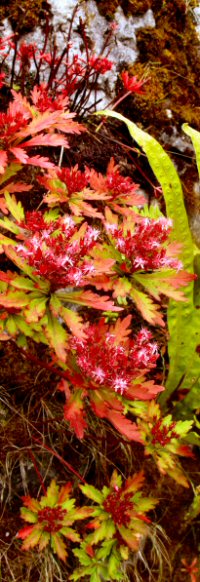
|
Back in the Himalayas there had been a particularly attractive plant eluding our grasp, until we finally nailed it at the appropriate time on our 2013 expedition. Although very distinct Rhodiola chrysanthemifolia WJC13669 etc was still difficult to pin down to a name. Locally common where we were collecting at high altitude in the Himalayas in 2013, little information appears to be available on this very ornamental species. Arising from a rootstock 5-10mm thick sometimes creeping, a deciduous species which can have stems to 30cm long, but only a fraction of that where we encountered them growing as epiphytes on tree trunks or mossy boulders as well as well drained steep hillsides. Forming a terminal ruff of broad fleshy leaves deeply pinnatifidly lobed or toothed, availing a fabulous backing to showy cymes of up to 40 bright pink flowers (from this area) July to October.
|
 |
Rhodiola himalensis WJC13723 was far more amenable. From one of our collections gathered from a deep valley north-eastern Himalayas in the autumn of 2013 at 3,400m. Where a small colony of this species had established as lithophytes on large boulders on a steep bank in good light. Arising from a sturdy upright rootstock with a terminal rosette of scaly buds and many radiating stems to 15cm long, clothed in fleshy linear grey-green leaves to 2.5cm long. Bearing terminal clusters of reddened upright seed capsules, which had succeeded the dark red, pinkish to yellow flowers recorded on this species.
|
 |
Our quest to find Cardiandra formosana was epic, whereas on our return we discovered the largest flowering clone of 'Fenghuangshan' BSWJ3615 with relative ease in 1996. Superficially appearing similar to a hydrangea with upwardly inclined branched stems with serrated leaves, terminating in large cymes of pink-purple flowers, the sterile florets the largest of any collection in this form, from late summer until Christmas or heavy frosts. A strange herbaceous perennial that took a considerable time and effort to find in the only foothold left in the wild, which is in an earthquake torn area of the Central Mountains of Taiwan. Resulting in us being able to offer plants back after the 1999 devastating earthquake obliterated 75% of the plants left in the wild.
|

|
The hard work was done for us with Rodgersia henrici KW21015 being a slice of the great collector’s original collection, tracked down and shared by Chris Sanders. A distinct clone originating from of Kingdom Ward's original collection of this very scarce species. For us it is a slow growing dramatic clumping perennial with strong upright stems to approximately 1m tall, bearing leaves 75cm across composed of as many as 8 radiating paddle-shaped leaflets, which are glossy deep bronze in colour for many weeks after emerging. Complemented by mid-summer with a many branched large inflorescence of pink flowers on stems to 1.3m.
|
 |
We like to give plants appropriate names Rodgersia nepalensis 'High Flier' HWJK2121 hopefully this name hints as to the higher altitude this much larger than normal form was found. A collection from a memorable day, when I left the rest of our party to find some altitude in the very north of eastern Nepal along the border with Tibet. I was not disappointed in finding many high altitude forms of plants only previously found lower. Such is the case with this species which I found in a deep moist shaded gully at 3,200m. Where the scattered plants were prominent due to their stature of 2m tall with large glossy bright green pinnate foliage. Unfortunately without seed, hence the single plant collected (legally), which has taken until 2015 to build up, meanwhile displaying its yellowish flowers to us in summer.
|
 |
Meanwhile our naming of Rodgersia pinnata 'Shangri-La' BWJ7741a was caught on camera, while filming with a German television company. Named for Zhongdian that some consider to have been Shangri-La, where I collected the seed of this again particularly large form in 2000. A selected form that I collected seed of in the high mountainous of China at 3650m altitude. This strong growing perennial was growing, where there was plenty of moisture during the growing period. From a stout rhizome fat buds stretch out in spring and unfurl to wonderfully textured pinnately arranged bronzy leaflets. Followed June-July, by huge branched panicles of white ageing to pink flowers on stems to 1.5m tall on this form.
|
 |
At long last we have a species name for Dan’s wonderful introduction Impatiens qingchanganica 'Emei Dawn' DJHC98415. A wonderful collection gathered at high altitude by Dan Hinkley on the fabled E'meishan, Sichuan China in 1998. A hardy perennial species arising from slowly creeping underground rhizomes, with lax fleshy stems to only 30cm tall carrying broadly elliptic crenate un-marked leaves. Bearing elongated helmet-shaped shell-pink all female flowers with long spurs and yellow darker spotted throats, from mid summer well into the autumn. It is such a shame we have lost our ever so keen Impatiens guru Ray Morgan, he will be missed. Then so will the Snowdrop Queen, Margaret Owen (or was she the empress) who will keep us in line now?
|
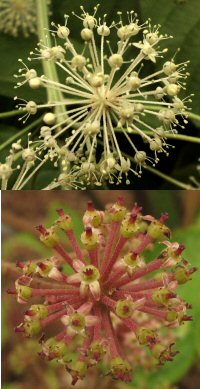 |
There were rumblings that Aralia continentalis and cordata were indistinguishable. Alas I have to admit they are easily distinguished in flower, which is how I discovered my oversight in our collection from Ullüngdõ BSWJ8524, now firmly in the Aralia cordata camp. One of the most impressive large perennial species, with stout slightly hairy stems forming imposing architectural clumps to 4m tall, when established. Clothed in large alternate bipinnate leaves, topped in July-August by large terminal racemes to 1.5m long, of cream-green flowers soon followed by globose purple-black fruit. Originating from one of our collection from South Korea gathered from the remote island of Ullüngdõ 80km off the north-eastern coast in 2001.
|
 |
Which brings me neatly to another identity that has been puzzling many growers. We were given a statuesque species of Angelica without a name, it was duly planted out in a new garden we were developing. It took a few years, but the resulting inflorescence was spectacular. That did not end, it lives on and on, getting larger each year, so I finally pulled my finger out and identified it as Angelica ursina, meanwhile gathered some seed to share it. Its not every day that you receive a welcomed gift from Siberia, alright it was via Ireland, but what a classic! Arriving here as a young seedling, which was immediately planted out in a fairly rough area of our garden. It slowly formed a wide basal clump of short purple stems with leaves composed of large ovate-oblong narrowly pointed leaflets thrice ternately pinnate (divided three times). Finally after a few years it thrust up an enormous sturdy bright red-purple slightly zigzagged stem, terminating in a large inflated bud of bracts, opening to an even larger wide terminal 60-100 rayed inflorescence each terminating in a round umbel of 30-40 white flowers.
|

|
There was a screeching of brakes as we left a village deep in the valley of the eastern Himalayas. We could not believe our eyes when we saw Angelica cyclocarpa WJC13658 just growing there at the side of the road, judge for yourselves from the image and no that is not a midget standing alongside it. What a great plant to kick off our collecting in northern Himalayas in the autumn of 2013. We could hardly believe our eyes when we first saw the sturdy upright stems to at least 2m (recorded up to 3.5m) tall. Topped by one of the widest umbells I can remember seeing, composed of several 30cm wide umbells, which would have flowered a yellow-green July to September, resulting in the flat rounded seed we were collecting. The basal leaves, which were dormant at that time, are recorded as being 1m wide ovate in outline, 3-pinnately divided lobed and serrated, with conspicuously large petiole wings, more so on the upper leaves.
|

|
That was the only plant we saw (in a month) apart from an Angelica nubigena WJC13763 in the next valley, with equally large umbel, but much shorter and rarer. We felt extremely lucky to find this smaller species seeding at a mere 1.2m tall (recorded to 2m) at almost 4,000m. The sturdy purple stems were topped by many very wide umbels composed of 50-rayed flat topped umbells of 30 pale yellow flowers, resulting in the disc-shaped seed we were collecting. The basal leaves which were dormant at that time, arise from long thick rhizomes, they are recorded as being 40cm wide ovate in outline, 3-pinnately divided deeply lobed and serrated, with inconspicuously winged petioles.
|
 |
We also collected another Selinum confirming that our Nepalese collection was Selinum candollei HWJK2329 and what we were looking at (and gathering seed) was Selinum wallichianum WJC13656. A seed collection gathered on our first day in the Himalayas in the autumn of 2013 at 2900m, where a small colony grew in scrub, to about 1m tall with some still in flower. Here they formed neat clumps of basal long stemmed 3-5 times finely divided leaves on upright branched stems. With wide terminal flat hairy umbels of white flowers with distinct greenish white edged bracts July to September, followed by winged seed. Meanwhile our Vietnamese collections were identified as Selinum cryptotaenium FMWJ13250 etc.
|
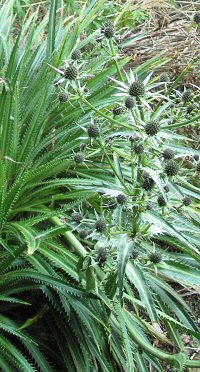
|
The winter of 2010/11 was responsible for eliminating anything tender in our fields, the lengths we go to shorten our plant list. One surprising survivor in a spot that went down to as low as –20C was Eryngium cymosum BSWJ10267 which we are pleased to reintroduce, thinking we had lost it. From one of our seed collections on Volcán Pico de Orizaba, Veracruz Mexico. A rare high altitudinal species forming a basal rosette of narrow strap-like leaves, with a single row of stout flattened spines along each margin. With a sturdy upright much branching stem to 1.5m tall, bearing umbels of spiny distinct black-darkest brown flowers backed by large bracts on short branches all up the stem.
|
 |
It will be interesting to see how we get on with yet another Mediterranean Ferula, we couldn’t resist Ferula tingitana BSWJ14005 found near our pigeon hole in southern Spain. Only seen in their desiccated state by ourselves, when collecting the seed of these glorious large architectural perennials in the mountains of Andalucia southern Spain in the summer of 2014. Growing in close proximity to spiny cactus on a steep rocky hillside, indicating the growing conditions required to satisfy this plant. Where many of the wide mound forming plants had grown into tall single stemmed plants to 3m, green glaucous with few branches subtended by large inflated sheathes. With few linear leaves almost thread-like and large rounded terminal umbels of flat seed, which were the result of the yellow spring flowers
|

|
Thapsia maxima BSWJ12989 is another indulgence from there, I was completely ignorant of its charm, those huge umbells are irresistible. Only seen in their seeding state by ourselves, when scouring the landscape for useful seed of these types of glorious architectural perennials in the mountains of Andalucia southern Spain in the summer of 2013. Growing in close proximity to pines and cactus on a steep rocky hillside, indicating the growing conditions required to satisfy this plant. By which time the 2-3 × pinnate, heavily lobed and toothed basal leaves were dormant. Although recorded as attaining 2.5m in height where this seed was collected in harsh exposed conditions they were only around 1m tall, although we have since seen some much further inland that were 2m tall. All the same the seed heads or large umbells were impressive around 30cm across with around 25 radiating stems with umbells of translucent winged seed, the result of the yellow flowers born May-June.
|
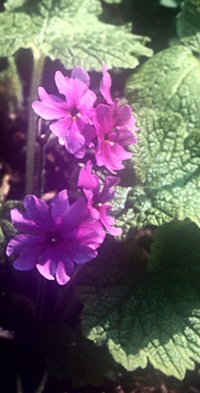 |
Primula kisoana was on our list some time ago, luckily we have some plants to offer once more. A wonderfully unusual species from Japan grown primarily for its extraordinary hairy palmate foliage. Also valued for its stoloniferous habit soon covering a sizeable area when happy and its many umbels of pink flowers in April-May.
|

|
Not so with Primula smithiana BSWJ13951 identified by Hugh McAllister. Luckily mentioned to him in passing, he knew of the moist spot on the Singalila Ridge where this purple flowering rarity occurs. From one of our collections gathered between Kalapokhari and Sandakphu at 3175m during our trek along the Singalila Ridge, Darjeeling District northern India in 2013. A rosette forming species composed of 20cm long oblong-lanceolate leaves held on winged petioles. Giving rise to1-3 strong scapes to 60cm tall carrying up to 3 whorls of seed capsules at this location, which succeeded the purple 2cm wide flowers.
|
 |
Another Himalayan is Scopolia anomala HWJK2252 which has quietly crept up on us with some intriguing flowers on a chunky plant, that are completely engulfed by its calyx, great when dried. From one of our high altitude seed collections on our epic trek in eastern Nepal in the autumn of 2002 with Dan Hinkley et al. Where we found this large perennial species to 1.2m tall being cultivated on the edge of the village of Thudam on the border with Tibet. With very robust pale green glabrous branched stems with ovate thin textured softly hairy leaves to 20cm long. Which almost hide the distinct pendant flowers when first emerging from the axils, until that is the calyces start to inflate to 5cm long strongly ribbed and bristly, with the yellow purple stained flower lobes pertruding at their openings May-August. The calyx elongating after flowering to completely hide the enclosed strange seed capsule with an opening lid which reveals the enclosed round brown seed October-November.
|
 |
I could not for the life of me figure out until later what Digitalis obscura BSWJ14010 was, I just liked the form and was willing to give it a go. Forming more of a sub-shrub to around 1.2m tall much branched at its base, bearing willowy narrow deep green leathery and glossy foliage. The branches terminating in 20-30cm long spikes of funnel shaped orange-yellow to brownish-red long lower lipped flowers that are spotted and netted within May to August. From one of our seed collections gathered from The Sierras de Tejeda, Andalucia, southern Spain in 2014.
|
 |
Have another go is what we intend to do with Cremanthodium reniforme WJC13710 etc as they are so irresistible, if we only had the cool exposed conditions they require. From seed we collected from 3260m, growing on a large boulder. Only forming a low growing perennial species, with thick textured kidney-shaped basal leaves on long stalks. Bearing upright sturdy hairy stems to 45cm tall, holding a solitary nodding yellow ray flower to 7cm across, July-September.
|
 |
Parasenecio like it cool too, but we can do that in our woodland adding chunky Parasenecio auriculata var. kamtschatica BSWJ12574. A collection gathered from deep in the forest within the Odaesan area of South Korea, collected in the autumn of 2010, growing by a moist ditch. Where it had formed a small colony of 1m tall stems which were shortly branched in their upper parts. While the foliage was an unusual hastate-shape 20cm across, with long tips to the five shallowly winged petioles held on winged petioles. With a sizeable terminal panicles of racemes of white tubular-shaped ray flowers.
|
 |
Parasenecio mortoni GWJ9419, is a name change, from a collection we originally made on the Singalila Ridge, Northern India, at 3400m. A robust perennial with large palmately deeply divided and sharply lobed basal leaves. With on a separate flowering stem to 1.5m tall, a broad many flowered cyme. One of our collections of an interesting composite which we had seen in the past, but without viable seed.
|

|
The short species Eupatorium lindleyanum var. trisectifolium BSWJ12742 caught our attention on the wonderful south coast of Korea, its foliage easily sets it apart for me. From Kõjedo one of the main islands easily accessible along the south coast of Korea during our expedition there in the autumn of 2010. Only forming a relatively short species normally to around 80cm tall in good light mixed with grasses and other small perennials, close to the coast where we collected the seed. Forming small clumps of slender purplish un-branches stems, with whirls of narrow lanceolate sharply serrated leaves with a purple cast below, at regular spacing up the stems. Bearing terminal corymbs of funnel-formed dark pink-white flowers summer-autumn.
|
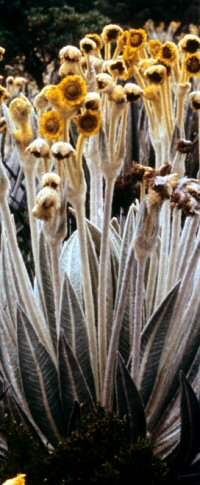 |
A final composite is Espeletia we are adding a couple thanks to young Daniel Bristow, although the identities are a bit tenuous as Espeletia aff. killipii DCB. A striking looking plant that we encountered in the Paramo not that far from Bogota in southern Colombia on our first visit there in 2004. Growing in a small colony of rosette forming perennials with lanceolate leaves to 40cm long covered in silvery-grey woolly hair, while maturing the base of the plant extends to a short woody trunk 20cm long. Meanwhile from the leaf axils equally woolly arching terminally much branching stems to 75cm long bare yellow ray-flowers in a continuous succession.
|
 |
Espeletia aff. summapacis DCB, lets see if we can add to them. Growing in a sizeable colony of initially rosette forming perennials with large lanceolate leaves to 75cm long covered in creamy yellow woolly hair, while maturing the base of the plant extends to a woody trunk 1m long. Meanwhile from the leaf axils equally woolly arching terminally branched stems to 1m long bare large pale yellow ray-flowers in a continuous succession. One of the most striking looking plants that we have encountered on our travels, which we saw growing in the Paramo not that far from Bogota in southern Colombia on our second visit there in 2004.
|
 |
The gingers may be considered exotic by some, personally I’m in difficulty to understand why they are not more widely grown. Am I a ginger nut? Starting with Roscoea tibetica f. rosea one of this mostly hardy easy to grow genus, it is a small Chinese plants forming a rosette of broadly ovate leaves the bases clasping the short upright stems to 20 cm tall, which have arisen from the fleshy roots. Displaying the pale to mid-pink flowers held terminally in succession from the tip of the stem, orchid-like on long hollow tubes, with almost comical lateral petals protruding either side. Flowering for several months for us May to September. Common in open grassland with mixed scrub in mountainous areas of Yunnan and Sichuan.
|
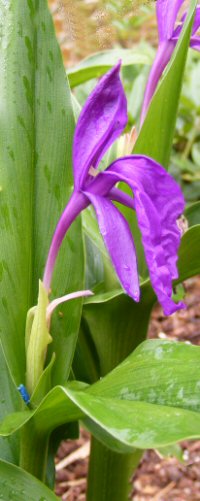 |
Roscoea tumjensis HWJK2211 is from our Nepalese collections from the type locality, wondered why it looked different to Roscoea auriculata. One of our collections from rocky outcrops after leaving the upper Arun Valley trekking close to the Tibetan border in North-eastern Nepal in 2002. Where this species with fleshy roots was prevalent on hot dry slopes at 3185m, with sturdy upright stems to 50cm tall. With stem-sheathing narrow foliage and congested terminal clusters of elongated seed capsules, which had succeeded the broad-lipped orchid-like successive purple flowers, April-July.
|
 |
Cautleya spicata ‘Crûg Compact’ BSWJ2690 has been with us for 20 years, so its about time we distributed some. Very distinct it forms a carpet of only short stems to 15cm (that’s 6’’ in old money). We have been waiting for it to shoot up, but time is up on that score don’t you think? A very distinct form of this species that we collected seed of from the Lachung Valley back in 1994. We have grown it in one of our fields since that time where it has only attained a maximum height of only 30cm, meanwhile forming a dense mat of rhizomes. With dark red upright short stems bearing long terminal inflorescences of dark red overlapping bracts with sizeable orange yellow flushed flowers over a long period June to October.
|
 |
Hedychium gardnerianum from the Azores BSWJ12533 is welcome to try and colonise here. A pretty weed if ever there was, maybe we are lucky to live in a climate where they cannot run wild, climate change would have to go some for that. Originating from one of our seed collections gathered on the high mountains of Sao Miguel Island, part of the Azores in 2008. Where they have made themselves very much at home in the relatively frost free environment, forming large colonies of overlapping rhizomes with stems up to 2m tall (1.5m with us). Bearing semi-evergreen paddle shaped leaves glossy above glaucous below, terminating in a large cylindrical inflorescence of yellow flowers with long exerted orange stigmas late summer into autumn..
|

|
Hedychium tengchongense ’Trum Trom’ HWJ684 is going to create a stir, not least for the properties it has in hardiness, early flowering, stature (short) and fragrance. Who wants to bite my hand off first? A small distinct form of this species which we collected from The Trum Trom Pass the highest pass in Vietnam at just over 2000m. Where it grew on moist shaded vertical cliffs, with reddened upright stems to less than 1m tall in those conditions. Initially mistaken for a Cautleya, but obviously not on flowering here the following year. Bearing broadly ovate dark green leaves on very short petioles, with a broad cylindrical inflorescence of white long-tubed slender distinctly scented flowers with long curved orange-red exserted stigmas mid-summer.
|
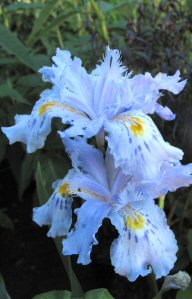
|
Iris wattii KWJ12172 was a strange find in the mountains of Vietnam, where I assumed it to be Iris confusa, that is until it flowered, some difference, then the stems stretched. Not being a great fan of Iris there has to be something special to tempt me to collect one. Now this species has something about it, when I saw it growing on Dragon's Tooth Mountain on limestone behind the town of Sapa in northern Vietnam. The stems were only attaining 60cm of height in the exposed conditions, whereas in shelter this species can attain 2m. With broad strap shaped evergreen glossy leaves topped by some magnificent blue and white orange spotted frilly looking flowers April-May.
|
 |
Iris formosana BSWJ1951 will be a welcome return after being absent for so long, hope we can keep up with demand this time. A rhizomatous perennial species that we collected from the Wushe area of eastern Taiwan in the autumn of 1993. With slender creeping rhizomes forming large colonies on steep shady cliffs, with leaves 40-50cm long. Inflorescence are held on erect stems in summer, composing of showy orchid-like, white, green and pale blue flowers.
|
 |
While in the Pacific NW we were treated to a visit to see Veratrum viride hope we can grow them to that size, they were impressive even in the state we found them as the snows closed in, we will have some LIL127-01 collections. Originating from the Pacific North West of North America, where we have seen remarkable colonies of this species high up on Mount Baker in Washington State. A truly fantastic robust species forming substantial clumps with sensationally pleated broad leaves to 40cm long and half that in width. With strong upright stems to 2.4m tall of branching drooping panicles of large green-tinted white to green flowers, each petal bearing a dark green V at its base, June-September.
|

|
We will also have a fresh collection of Lilium leichtlinii var. maximowiczii CWJ12825 a charmer if you like orange. A Japanese collection of this species emerging from a white bulb which can send out horizontal stolons, forming stems to 1.2m tall with scattered linear-lanceolate leaves. Topped by an inflorescence of up to 12 orange turk's cap flowers brown-purple spotted, opening from July to August. My collection gathered with Finlay Colley in a mountainous area of Oita in 2010, growing on a steep bank at the edge of the forest where it had formed a small colony.
|

|
Look away now if you are getting fed up of all the recent name changes, as here comes another Polygonatum mengtzense f. tonkinensis is bit of a concession, as we introduced this distinct evergreen species as Polygonatum tonkinensis a long while back, this new combination covers the purple stemmed red flowered form, leaving the white-green as the type species. Our most popular species due to the retention of its alternate thick-textured slender foliage in milder climates like our own. Held on strikingly bright purple arching stems which are even brighter when the red fruit are still attached as they can be for months on this species, which are the result of the purple-red small flowers held in clusters in all the leaf axils, even the terminal. From one of our seed collections gathered from our river camp deep in the forest of the highest mountain in Vietnam in the autumn of 2000.
|
 |
While Polygonatum singalilense was introduced into cultivation as Polygonatum geminiflorum some time ago, I know the name is still on our list, some people will not read the small print. Originating from high elevation in the western part of the Himalayas, a small species arising to only 25-30cm from a rather bizarre running rhizome, which can morph into two forms. Bearing oblong dark green 5-8cm long leaves which can be held opposite or in whirls, with axillary pendant waisted white green flushed flowers held on long slender stalks May-June.
|
 |
I was fortunate to see plenty of Polygonatum multiflorum in the spring on a visit to Arboretum Wespelaar, in Belgium, what a treat that was. We are so lucky that someone actually does care enough to create a place like that. A long cultivated pan-European perennial arising from stout slowly creeping rhizomes soon forming clumps to 60cm. wide. Forming arching stems 50-100cm long of alternate leaves, bearing axillary clusters, during May and June of long white bell like flowers which typically recurve at their green tips.
|

|
Polygonatum cathcartii yellow flowered BSWJ2429 is so different from our other collections of the species I was convinced it was a different opposite leafed species. It is hardly common knowledge that many species grow as epiphytes, such is the case with this very distinct deciduous species. Where we fond it growing on the sturdy branches of trees even up to the tree line in Sikkim on our first expedition there in 1994. Here the leaves were bright yellow contrasting with the red fruit which were the result of the long tubular distinctly yellow flowers, held on long slender stalks.
|

|
I hate to work out how long its taken us to build up a stock of Streptopus roseus, this is another gem from the Pacific NW and beyond, so why has the name been changed to Streptopus lanceolatus. A legendary woodland perennial which has taken us well over ten years to build up a saleable stock (actually lost count). Originating from the mountainous and cold northern forests of North America. From slender mat-forming rhizomes, with simple only rarely branched leaning stems 15-40cm long, bearing slightly hair fringed ovate-elliptic leaves and 1-2 axillary pendent pink bells spring to mid-summer, followed by dark red berries.
|
 |
Maianthemum bifolium ssp. kamtschaticum small form at least did not change its name, or did it I forget. If you prefer a smaller form of this spreading woodlander this is your man. A relatively small form of this herbaceous species from The Far East. Arising from thin rhizomes which carpets the forest floor with short vertical stems bearing glossy deep-green heart-shaped leaves. Which becomes a butter yellow in the autumn, contrasting with the red current-like fruit, that succeeded the small white scented flowers.
|
 |
Who would have guessed that Disporum are in the Colchicum family? Yet when the case for separating the North American section into Prosartes we are reverted to another system, as we step back in time to the Liliaceae family. I must be missing something, probably in my education.
|
 |
Here we go again, its taken a while, but looks like we are there Reineckea incurva 'Crûg's Linearleaf' BWJ8029 has finally been identified. Originating from one of my plant collections gathered from Longzhoushan Sichuan with Dan Hinkley in 2000. Of a very distinct form (some including myself believe there are more than one species) of this evergreen woodland perennial closely related to lily of the valley. The form we are allocating this cultivar name arises from long to very long underground slender rhizomes, to tufts of linear grass-like dark green leaves more reminiscent of Ophiopogon or Liriope. Forming a dense carpet of upright dark foliage to around 20cm tall. Bearing palest pink lily of the valley-like flowers on contrasting reddish stems August-October.
|
 |
While Aspidistra daibuensis 'Taiwan Stars' has been assigned a cultivar name, after a request from Tony Avent of Plant Delights, NC USA, because it flowers so profusely. Evergreen perennial, from strong creeping densely scaly rhizomes, forming dense colonies of lanceolate glossy deep green, yellow spotted leaves. Annually producing yellowish campanulate flowers near ground level, followed by a globose berry.
|